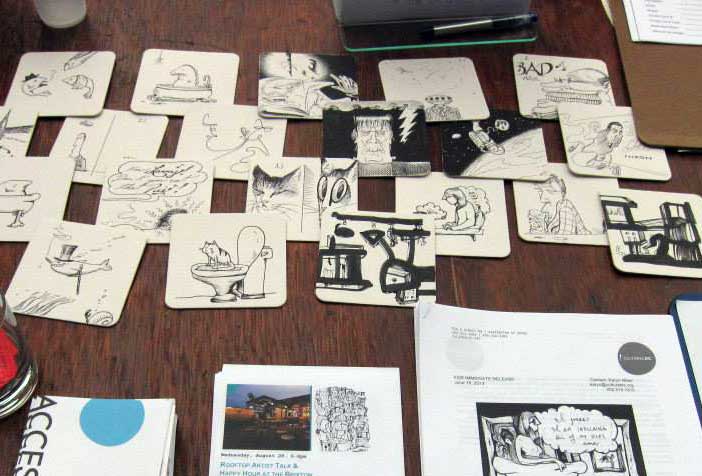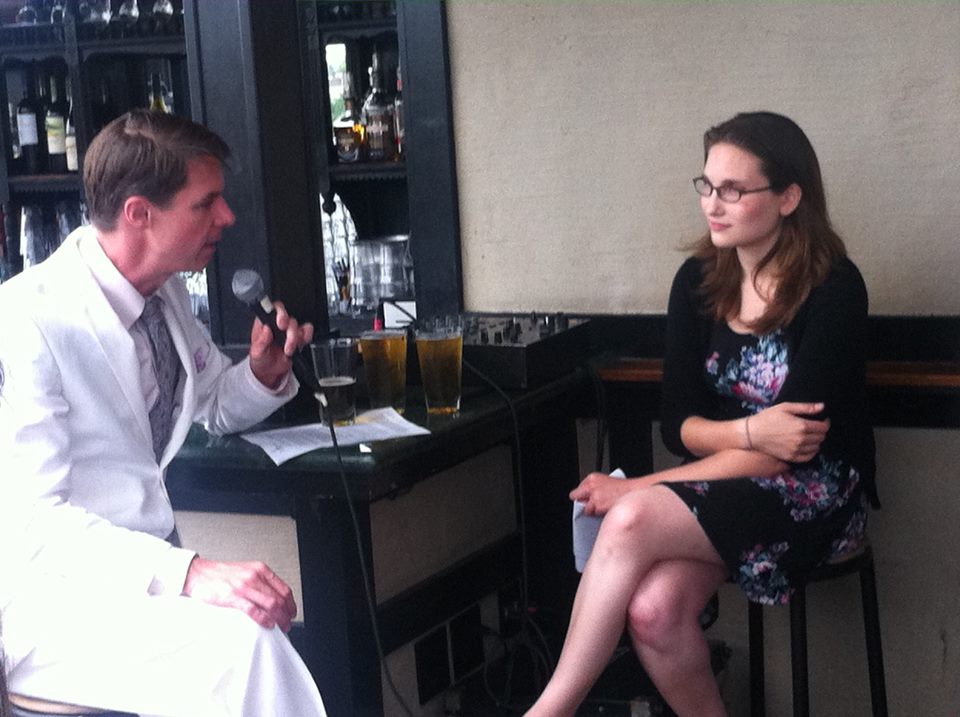Last Wednesday I had an artist talk with essayist/cartoonist/person-in-the-world-expert Tim Kreider (who also very kindly helped me draw coasters to raise money for Cultural DC). The following is our email correspondence pre-interview, to give you a gist of some of what was said. TK: I once had a woman get mad at me for calling her a cartoonist when she considered herself a fine artist. You’ve been called an illustrator, which I know you feel is simply inaccurate. Your work seems to occupy an indefinite ground somewhere between cartoon, illustration, and fine art. What do you call yourself? Or do you find the whole business of categories tiresome and irrelevant?
DM: I do find the business of categories tiresome up to a point, but I understand the impulse to label things—it’s good to know where the art fits in the ecosystem. And I find it very interesting how often I’m pegged as an illustrator, even though I’m always the first to point out that I’m not actually illustrating anything. So it could very well be that everyone else sees a style of drawing and thinks, “illustration” whereas I see illustration as more of art with a very specific purpose. I will say that the worst art I’ve done in my life, the stuff that still makes me wince when I look at it, has been actual paid illustration work—that is, someone told me what kind of drawing they wanted, and what subject matter, and written me a check for my trouble. But I’ve done some “assignments” I’m very proud of for people who gave me one or two loose parameters and said, okay, go nuts.
If I were to be thorough, I’d describe myself as a fine artist with a background in illustration and who occasionally makes a comic or two, if the mood strikes.
TK: Do you feel like being an in-betweenish kind of artist makes career more difficult, because people like to be able to pigeonhole?
DM: Well, being an artist is hard no matter what. There is always a reason to feel aggrieved and like no one is paying attention to you or taking you seriously. I guess the taxonomy would probably be a lot easier if I was a cartoonist or illustrator, but I’m stuck drawing the way I do, so there you go.
TK: There’s an aspect of your work that looks appealingly made-up-as-you-went-along, almost like automatic drawings. Not to say that they’re sloppy or unstructured, but in a way they’re like very ambitious doodles, done without the interference of some teacher telling you to stop that right now and pay attention. What is the balance between spontaneity and planning in your work? Do you have an overall composition or design in mind when you begin? Or are you actually making it up as you go along?
DM: They are mostly made up as I go along. Composition-wise I’ve found it useful to make sure I know where the drawing ends on the paper or wall, maybe start with a loose sketch of where I want certain shapes to go, but then just plunge in and try not to overthink it. For my smaller pieces I will sometimes start with a few ink blobs, or some sort of doodle, and see what happens. I do the best work if I have an engaging audiobook to listen to and can put myself on autopilot. (All of the work in my show has an audiobook I associate with it, except for one piece in particular that I drew while binge-watching House of Cards.)
Apparently there is a psychological term called, “The Centipede’s Dilemma” which is what happens when thinking too hard about what you are doing will cause you to mess it up. [The Wikipedia definition: “when a normally automatic or unconscious activity is disrupted by consciousness of it or reflection on it.”] My drawings are the result of having a bad case of that.
TK: So talking about it is probably a bad idea.
DM: It’s more that I can’t talk about it very easily. I don’t like the word “stream of consciousness” for my process, since it sounds a bit wishy-washy, but I can’t think of a better word...eh, maybe I should just own it already. But it’s a bit terrifying—if it all comes from your subconscious, a place you don’t really understand and can’t control, it’s easy to imagine that the spigot can get turned off at any moment.
TK: There are these little recurring figures and images in your work—bathtubs, chessmen, stairs and balustrades, fish with scarves. I have similar little figments that infest my own drawing, too, mostly much dumber and more embarrassing than yours—Dracula, the starship Enterprise, etc. Where does that stuff come from? Do you think it’s like dream imagery, symbols for something you’re preoccupied or obsessed with, or is it just the clutter and junk left lying around in your head?
DM: I wouldn’t call it clutter, exactly, just the images that I can always fall back on because I never get tired of drawing them. I’m not sure where the chess pieces come from, but I love how each one has a distinctive personality, and sometimes have loaded symbolism that I can trot out if needed. Like, you see a chess piece or a chess game, and it’s an automatic story. Even if the pieces are just sitting there and no one’s around, there’s a narrative injected into the image somehow.
The bathtubs I began drawing when I saw an illustration of one in a newspaper (a review of some old-timey children’s book), with the little fish-like character in it. It had some funny nonsense name, like the Sploo. The image stuck in my mind and I began drawing it incessantly. What’s great about drawing claw-footed bathtubs is that they are always imperfect--one side is wonky, or the feet aren’t curved quite right, or whatever. I don’t think I’ve ever done a bathtub I’ve completely nailed. Which means I feel as though I need to draw bathtub after bathtub after bathtub to get to the perfect one.
If I were to play dimestore psychologist I could translate my little, “when in doubt, draw a fish wearing a scarf” manifesto to a shorthand for, ‘when it doubt, do something you’re reasonably good at, is kind of silly, and that you can do over and over again without getting bored.’
TK: Maybe this is a good prescription for life in general.
DM: I can think of worse ones.
TK: I guess part of the reason your drawings feel cartoonish is that there’s a humor to them—those little characters with their big noses, the smug-looking cats. But there’s also a sadness to them that reminds me of cartoonists like Michael Leunig. All these morose-looking figures isolated from one another in their cramped bare apartments. It reminds me of the experience of living in New York City—these sprawling ramshackle tenement-like structures, cutaway views of these lonesome people all living on top of one another, separated only by thin walls. Are you conscious of this sadness in your work—is it something you’re deliberately trying to express? Or does it just come out that way? Or am I projecting it all? Is it me who’s sad?
DM: One of the themes in this show is how we are all pretending--to be more competent, less desperate, better people in general, as though we are all very certain of ourselves. On one hand it’s important that we all do this--the social order would probably all fall apart if we all got to act how we really felt at any given time, but it’s also exhausting. And yes, it’s only once we’re alone in our tiny cramped apartments that we do get to be honest with ourselves. And even the honesty can be a confusing mess.
I see them as sad in the same way that I see Edward Gorey drawings as creepy and disturbing—that is to say, I don’t, really. The characters might all look as though they’ve had better days, but I always thought the silliness and absurdity of the drawings prevents viewers from taking it too seriously. You can read an Edward Gorey book about children dying and you will chuckle with amusement, not say, “oh God, that’s terrible.” But that’s my own take on my work. I do realize with my stuff there’s no obvious punchline or gag the way there is with an artist like Gorey, so maybe the viewer is left with a sad feeling. One of the best parts about having all this work out there is that it’s completely out of my hands.
TK: You’re right, and I partially retract my previous question. People always used to call my own cartons dark, sick, cynical, bitter, and I could see what they meant but I also felt like they were missing out on the fact of the cartoons themselves, which were hilarious and fun, acts of joy. There’s a difference between how you perceive the world to be and the way you choose to react to it.
DM: That’s a very good point. It sounds counter-intuitive, but drawing horrible things can actually be a damn good time.


